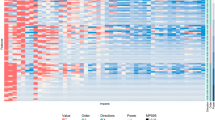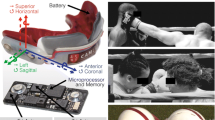Abstract
Although Head Injury Criterion (HIC) is an effective criterion for head injuries caused by linear acceleration such as skull fractures, no criteria for head injuries caused by rotational kinematics has been accepted as effective so far. This study proposed two criteria based on angular accelerations for Traumatic Brain Injury (TBI), which we call Rotational Injury Criterion (RIC) and Power Rotational Head Injury Criterion (PRHIC). Concussive and non-concussive head acceleration data obtained from football head impacts were utilized to develop new injury criteria. A well-validated human brain Finite Element (FE) model was employed to find out effective injury criteria for TBI. Correlation analyses were performed between the proposed criteria and FE-based brain injury predictors such as Cumulative Strain Damage Measure (CSDM), which is defined as the percent volume of the brain that exceeds a specified first principal strain threshold, proposed to predict Diffuse Axonal Injury (DAI) which is one of TBI. The RIC was significantly correlated with the CSDMs with the strain thresholds of less than 15% (R > 0.89), which might predict mild TBI. In addition, PRHIC was also strongly correlated with the CSDMs with the strain thresholds equal to or greater than 20% (R > 0.90), which might predict more severe TBI.






Similar content being viewed by others
References
Broglio, S. P., B. Schnebel, J. J. Sosnoff, S. Shin, X. Fend, X. He, and J. Zimmerman. Biomechanical properties of concussions in high school football. Med. Sci. Sports Exerc. 42:2064–2071, 2010.
Dokko, Y., R. Anderson, J. Manavis, P Blumburgs, J. McLean, L. Zhang, K. H. Yang, and A. I. King. Validation of the human head FE model against pedestrian accident and its tentative application to the examination of the existing tolerance curve. In: Proceedings of 18th International Technical Conference on the Enhanced Safety of Vehicles (ESV), Paper No. 322, 2003.
Donnelly, B. R., R. M. Morgan, and R. H. Eppinger. Durability, repeatability and reproducibility of the NHTSA side impact dummy. In: Proceedings of 27th Stapp Car Crash Conference, SAE 831624, 1983.
Ewing, C., D. Thomas, L. Lustic, E. Becker, G. Willems, and W. Muzzy. The effect of the initial position of the head and neck on the dynamic response of the human head and neck to –Gx impact acceleration. In: Proceedings of 19th Stapp Car Crash Conference, SAE 751157, 1975.
Feist, F., J. Gugler, C. Arregui-Dalmases, E. del Pozo de Dios, F. Lopez-Valdèz, C. Deck, and R. Willinger. Pedestrian collisions with flat fronted vehicles: injury patterns and importance of rotational accelerations as a predictor for traumatic brain injury (TBI). In: Proceedings of 21st International Technical Conference on the Enhanced Safety of Vehicles (ESV), pp. 15–18, 2009.
Gadd, C. W. Use of a weighted-impulse criterion for estimating injury hazard. In: Proceedings of 10th Stapp Car Crash Conference, SAE 660793, 1966.
Guskiewicz, K. M., J. P. Mihalik, V. Shankar, S. W. Marshall, D. H. Crowell, S. M. Oliaro, M. F. Ciocca, and D. N. Hooker. Measurement of head impacts in collegiate football players: relationship between head impact biomechanics and acute clinical outcome after concussion. Neurosurgery 61:1244–1253, 2007.
Hardy, W. N., C. D. Foster, M. J. Mason, K. H. Yang, A. I. King, and S. Tashman. Investigation of head injury mechanisms using neutral density technology and high-speed biplanar X-ray. Stapp Car Crash J. 45:337–368, 2001.
Hertz, E. A note on the head injury criterion (HIC) as a predictor of the risk of skull fracture. In: 37th Annual Proceedings of the Association for the Advancement of Automotive Medicine, Association for the Advancement of Automotive Medicine, pp. 303–312, 1993.
Kimpara, H., Y. Nakahira, M. Iwamoto, K. Miki, K. Ichihara, S. Kawano, and T. Taguchi. Investigation of anteroposterior head-neck responses during severe frontal impacts using a brain-spinal cord complex FE model. Stapp Car Crash J. 50:509–544, 2006.
Kimpara, H., Y. Nakahira, M. Iwamoto, S. Rowson, and S. Duma. Head injury prediction methods based on 6 degree of freedom head acceleration measurements during impact. Int. J. Automot. Eng. 2:13–19, 2011.
King, A. I., K. H. Yang, L. Zhang, W. Hardy, and D. C. Viano. Is head injury caused by linear or angular acceleration? In: Proceedings of the International Research Conference on the Biomechanics of Impact (IRCOBI), 2003.
Kleiven, S. Predictors for traumatic brain injuries evaluated through accident reconstructions. Stapp Car Crash J. 51:81–114, 2007.
Lowenhielm, P. Strain tolerance of the Vv Cerebri sup. (Bridging Veins) calculated from head-on collision tests with cadavers. Z. Rechtsmedizin 75:131–144, 1974.
Margulies, S. S., and L. E. Thibault. A proposed tolerance criterion for diffuse axonal injury in man. J. Biomech. 25(8):917–923, 1992.
Maxwell, W. L., J. T. Povlishock, and D. L. Graham. A mechanistic analysis of nondisruptive axonal injury: a review. J. Neurotrauma 14(7):419–440, 1997.
Nahum, A. M., R. Smith, and C. C. Ward. Intracranial pressure dynamics during head impact. In: Proceedings of the 21st Stapp Car Crash Conference, SAE 770922, pp. 339–366, 1977.
Nakahira, Y., K. Furukawa, H. Niimi, T. Ishihara, K. Miki, and F. Matsuoka. A combined evaluation method and modified maximum likelihood method for injury risk curves. In: Proceedings of the IRCOBI Conference, pp. 147–156, 2000.
Newman, J. A., C. Barr, M. C. Beusenberg, E. Fournier, N. Shewchenko, E. Welbourne, and C. Withnall. A new biomechanical assessment of mild traumatic brain injury. Part 2: results and conclusions. In: Proceedings of the 2000 IRCOBI, pp. 223–233, 2000.
Newman, J. A., N. Shewchenko, and E. Welbourne. A proposal new biomechanical head injury assessment function—the maximum power index. Stapp Car Crash J. 44:215–247, 2000.
Ommaya, A. K., and A. E. Hirsch. Tolerances for cerebral concussion from head impact and whiplash in primates. J. Biomech. 4:13–21, 1971.
Ommaya, A. K., P. Yarnell, A. Hirsch, and D. Harris. Scaling of experimental data on cerebral concussion in sub-human primates to concussive thresholds in man. In: Proceedings of 11th Stapp Car Crash Conference, SAE 670906, 1967.
Patrick, L. M., H. R. Lissner, and E. S. Gurdjian. Survival by design—head protection. In: Proceedings of 7th Stapp Car Crash Conference, SAE 1963-12-0036, pp. 483–499, 1963.
Pellman, E. J., D. C. Viano, A. M. Tucker, I. R. Casson and J. F. Waeckerle. Concussion in professional football: reconstruction of game impacts and injuries. Neurosurgery 53:799–812; discussion 812–814, 2003.
Prasad, P., and H. J. Mertz. The position of the United States delegation to the ISO Working Group 6 on the use of HIC in the automotive environment. SAE Paper #851246, Society of Automotive Engineers, Warrendale, PA, 1985.
Rowson, S., J. G. Beckwith, J. J. Chu, D. S. Leonard, R. M. Greenwald, and S. M. Duma. A six degree of freedom head acceleration measurement device for use in football. J. Appl. Biomech. 27:8–14, 2011.
Rowson, S., G. Brolinson, M. Goforth, D. Dietter, and S. Duma. Linear and angular head acceleration measurements in collegiate football. J. Biomech. Eng. 131(6):061016, 2009.
Schnebel, B., J. T. Gwin, S. Anderson, and R. Gatlin. In vivo study of head impacts in football: a comparison of National Collegiate Athletic Association Division I versus high school impacts. Neurosurgery 60:490–495; discussion 5–6, 2007.
Takhounts, E. G., J. R. Crandall, and K. Darvish. On the development of the SIMon finite element head model. Stapp Car Crash J. 47:107–133, 2003.
Takhounts E. G., V. Hasija, S. A. Ridella, S. Rowson, and S. M. Duma. Kinematic rotational brain injury criterion (BRIC). In: The 22nd International Technical Conference on the Enhanced Safety of Vehicles (ESV), Paper No. 11-0263, 2011.
Takhounts, E. G., S. A. Ridella, V. Hasija, R. E. Tannous, J. Q. Campbell, D. Malone, K. Danelson, J. Stitzel, S. Rowson, and S. Duma. Investigation of traumatic brain injuries using the next generation of simulated injury monitor (SIMon) finite element head model. Stapp Car Crash J. 52:1–31, 2008.
Tamura, A., K. Nagayama, T. Matsumoto, and S. Hayashi. Variation in nerve fiber strain in brain tissue subjected to uniaxial stretch. Stapp Car Crash J. 51:139–154, 2007.
Thibault, L. E., and T. A. Gennarelli. Biomechanics of diffuse brain injuries. Tenth International Technical Conference on Experimental Safety Vehicles, SAE 856022, 1985.
Trosseille, X., C. Tarriere, F. Lavaste, F. Guillon, and A. Domont. Development of a F.E.M. of the human head according to a specific test protocol. In: Proceedings of 36th Stapp Car Crash Conference, SAE 922527, 1992.
Versace, J. A review of the severity index. In: Proceedings of the 15th Stapp Car Crash Conference, SAE 710881, 1971.
Viano, D. C., and P. Lövsund. Biomechanics of brain and spinal cord injury: analysis of neurophysiological experiments. J. Crash Prev. Injury Control 1:35–43, 1999.
Willinger, R., and D. Baumgartner. Human head tolerance limits to specific injury mechanisms. Int. J. Crashworthiness 8(6):605–617, 2003.
Acknowledgments
We would like to thank Dr. Steve Rowson and Dr. Stefan M. Duma of Virginia Tech—Wake Forest University, School of Biomedical Engineering and Sciences collecting the 6DOF sensor data used in this study. And we also thank Dr. Viano and Dr. Shewchenko of Biokinetics and Associates Ltd. for providing the NFL data.
Conflict of interest
The THUMS™ has been developed by Toyota Central R&D Labs., Inc. (TCRDL) and Toyota Motor Corporation (TMC) in conjunctions with the Wayne State University (WSU). The authors work for TCRDL which has a financial interest in the THUMS™. However, there is no financial interest in the basic ideas of this study regarding RIC and PRHIC.
Author information
Authors and Affiliations
Corresponding author
Additional information
Associate Editor Stefan M. Duma oversaw the review of this article.
Rights and permissions
About this article
Cite this article
Kimpara, H., Iwamoto, M. Mild Traumatic Brain Injury Predictors Based on Angular Accelerations During Impacts. Ann Biomed Eng 40, 114–126 (2012). https://doi.org/10.1007/s10439-011-0414-2
Received:
Accepted:
Published:
Issue Date:
DOI: https://doi.org/10.1007/s10439-011-0414-2




